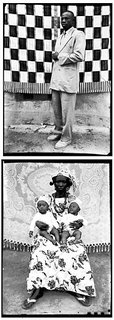
By MICHAEL RIPS @ New York Times
EVEN by the elevated standard of the New York art world, the rumor was exceptional: a tin of negatives buried in Africa for three decades that, when opened, revealed the work of a photographer who was neither "outsider" nor "indigenous" but spectacularly modern. And so the bejeweled and bohemian showed up at the Gagosian Gallery the evening of Oct. 18, 1997, wearing Fulani bracelets beneath their Charvet cuffs, blouses referencing Matisse referencing North African fabrics, Xhosa men in dinner jackets.
As accustomed as they were to art-world rumors, as familiar as they had become with exaggerations in the photo market, they could not help but be impressed. They saw mural-size black-and-white portraits in which the intricate designs of tribal costumes were set against backdrops of arabesque and floral cloths, the subjects disappearing into dense patterning that suggested Vuillard. A number of the photographs sold immediately, at prices of up to $16,000, and by the end of the evening, many in the crowd stood childlike in front of their limousines, waiting to catch sight of the photographer whose images they would never forget.
He finally appeared, old and regal.
The show was uniformly well received. Margarett Loke, writing in The New York Times, described Seydou Keïta as "the man who brought renewed vitality to the art of photographic portraiture." An article in Artforum praised the show, noting that the photographs "were very successful with sophisticated New Yorkers."
READ ON
1 comment:
The interesting thing about this case is that Rips fails to point out that Pigozzi never made out a $0.01 out of Seydou Keita. The same can't be said for either Kelly or Patras. Rips' article was very one-sided. Interesting that I should be in the Sean Kelly gallery this weekend and Rips was chatting with the staff there. Interesting article but very one-sided.
Post a Comment